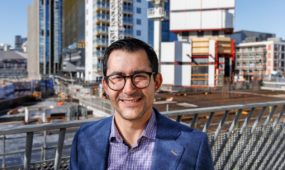Perfect aim helps Austofix hit overseas markets
Health & Medical
AN innovative gadget that removes the need for x-rays during orthopaedic surgery is helping a trauma device company expand into the Middle East and China.

Sign up to receive notifications about new stories in this category.
Thank you for subscribing to story notifications.
Austofix launched its Ezy-Aim Electronic Digital Targeting System last year and it is driving sales of its stainless steel and titanium surgical nails.
The device, developed in Adelaide, South Australia, allows the surgeon to accurately locate the implant inside the bone without the use of x-rays. This device and associated nails are used to repair fractures of the femur, tibia and humerus bones.
Austofix General Manager, Chris Henry said the device was key to the company’s recent success in the Middle East.
“The Ezy-Aim has been a catalyst for our growth in the Middle East. We have experienced double digit growth in a number of countries and we expect this to continue,” he said.
“It takes time to enter a market. In the Middle East you’ve got to understand how the dynamics of the market works – the registration period, are your products receptive to that market and can you service that market quickly.
“We meet all of these. Importantly, Australia is seen as a country producing quality products in the industry along with Germany, France and the United States.”
Austofix products are available in many Middle Eastern countries including Saudi Arabia and UAE. The company is also using the Ezy-Aim to solidify its presence in China, particularly in the Shandong Province, which has a Sister State relationship of 30 years with South Australia.
“They’re very supportive of Australian products … business is really growing in China. Again, our Ezy-Aim has helped increase sales,” Mr Henry said.
“Our experienced sales managers for both the Middle East and Asia have strong backgrounds in health, they understand the markets, the languages and associated cultures.
“The challenges facing us now is keeping up with demand from China and the Middle East. The timing of our expansion into other markets is dependent on reliable manufacturing partnerships to meet demand.”
The “other markets” on Austofix’s radar are India, South America, United States and Southeast Asia.
The company will next month launch its VRP2 wrist plate in Australia.
Mr Henry said the compact, universal wrist plate used patented locking technology to enable the screws to create an angulation of 40 degrees as opposed to the standard 30 degrees.
“There are key components of the plate manufactured using 3D printing, this enabled us to create a complex design without the costs associated with traditional manufacturing. It also enabled us to bring the device to market quickly,” he said.
“At the moment the wrist plate is our focus for the Australian market. As well as existing products we are also keeping our eye on the horizon and working on upcoming R&D projects.
“We understand that we need to establish good relationships with the users of our products, the clinicians.”
“It's important for us to have key opinion leaders who have used and support our product when we go to places in the Middle East, China, South America and Southeast Asia.”
Austofix was founded in 1993 by Dr Anthony Ingman. He is a former orthopedic surgeon at the Royal Adelaide Hospital who is still heavily involved with the company as its Technical Director.
The recent success represents a significant turnaround for the company, which endured several difficult years thanks to the GFC, a high Australian dollar and a tight European market.
“In 2012 we looked at what the strengths of the business were and we identified R & D, sales, marketing and commercialisation – getting a device to market from concept all the way through to the customer,” Mr Henry said.
“It’s a highly competitive market and we are a small company so we’ve got to understand our market and understand our position in that market. We pride ourselves on providing our customers with high quality, innovative products. Ultimately, together with the surgeon, our aim is to provide for the best outcome for the patient.”
South Australia is emerging as a hub for the medical devices industry.
Tomorrow, the state’s capital Adelaide will host the 9th annual AusMedtech conference for the first time.
The two-day event brings together over 250 medtech professionals and will explore advances in medical devices and technologies, including the impact of digital technology on patient care.
The city is also home to the new Adelaide BioMed City precinct, a $3 billion tripartite health hub comprising a soon-to-be-completed major hospital, research centres and educational institutions.
Jump to next article



